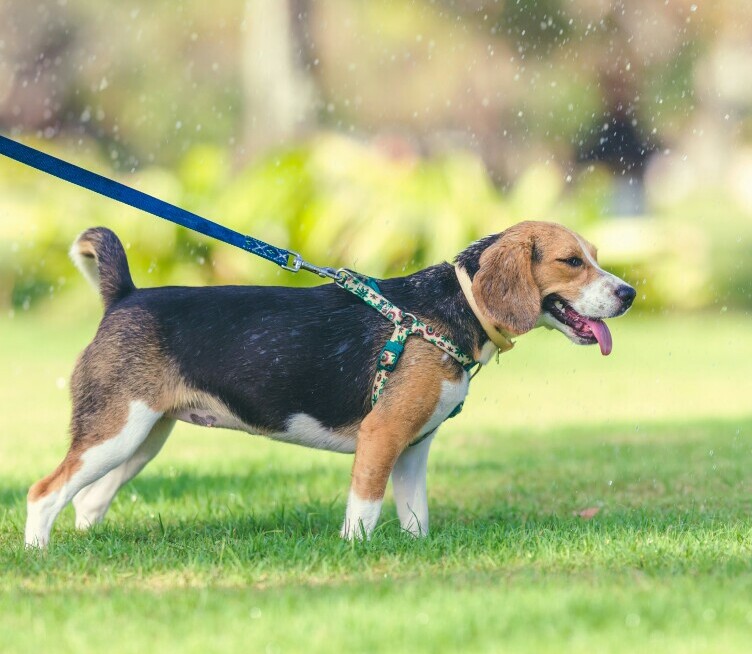
A few of the links in this post are affiliate links. If you buy something, we may earn a small commission (no extra bones from your wallet 🐾). Thanks for helping support the site and all of the dog adventures!
Have you ever felt like you’re being taken for a walk by your dog instead of the other way around? If so, you’re not alone. When dogs pull on their leashes, it can cause more stress on an outdoor walk than you would like. This is why we have got you covered with tips to help keep your dog from pulling while it’s on a leash.
Having a dog that pulls on the leash isn’t just a nuisance; it’s a genuine safety concern. You might notice the immediate discomfort in your hand or shoulder, but the implications run deeper and can affect both you and your best friend.
First, let’s talk about you. Consistent pulling places stress on your upper body. Over time, this can lead to strained muscles or even worse, falls and related injuries.
It’s especially risky for individuals with balance issues or lower body strength. If you are older or smaller with a bigger dog, this can spell trouble. Safety is the first thing you need to consider when walking your dog.
Now, consider your dog. The constant pressure against their throat from collars can cause harm to the trachea or thyroid. Harnesses that don’t fit properly or are not designed to prevent pulling may still allow a strong dog to tug relentlessly.
This could potentially harm their spine or leading to an erratic walking style that could cause joint issues. The constant tugging on their chest is not good for them over the long term, so we want to make sure that they get over their pulling habit.
While it might feel like an uphill battle, the aim isn’t just to stop pulling for the sake of convenience. It’s about preventing these serious risks before they become harsh realities.
The next section will offer you a toolkit of strategies – practical steps you can implement immediately to start seeing a change. Remember, training takes time, consistency, and a heap of patience, but the payoff is priceless: safe, enjoyable walks with your four-legged companion.
Using the right harness makes leash training easier. See options in Best Rated Dog Harness.
Looking for fresh dog food delivered? Click here.

Breaking the Habit: Proven Techniques to Discourage Leash Pulling
If you have a dog that pulls on the leash, we understand the frustration. But, good news: there are reliable ways to address this issue. Below, we’ll share techniques that have helped many dog owners to train their dogs for better leash manners.
Training a dog to walk on a leash without pulling is all about consistency. A simple method to start with is the ‘stop-and-go’ technique. The moment your dog starts pulling, STOP. Stand still and do not move until there is slack in the leash again. When your dog looks back and notices your position, praise them and proceed.
Over time, your dog will understand that pulling means no progress. You need to emphasize that when they pull then the walk will not proceed. This helps them understand that in order to continue their walk, they must stop forcefully pulling.
A good technique to use is to keep your dog at your side rather than walking in front of you. If you keep your dog at your side then you are walking in unison, and don’t allow the dog to follow it’s own path.
Dogs may come to think that they are controlling the walk if you let them walk in front of you. Keeping them by your side let’s you dictate where to go, and gives you all the control of the walk.
Patience is key as retraining your dog might take time, especially if pulling has been their norm for a while. Be prepared for walks to take longer than usual initially.
Regular training sessions will reinforce the behavior you want to see. With this, PLUS a reward system in place, your dog could soon associate loose-leash walking with positive outcomes like treats and praise.
Training aids, such as a front-clip harness or a head halter, can also make a big difference. These tools discourage pulling by gently redirecting your dog’s attention towards you or by making it uncomfortable for them to pull.
It’s crucial to get the right fit and introduce any new equipment gradually so your dog can adjust comfortably. Harnesses are nice cause they don’t tug on the dogs neck. This will prevent pulling and possibly injuring their neck.
It may take a little time for your dog to get used to, but once the initial fear wears off, these harnesses can be a great tool to use. It keeps them from being comfortable while pulling so that it unlearns this behavior, but it also keeps your dog safe and there isn’t as much risk of injury as a standard leash and collar.
We personally don’t use choke collars. Although there are people who claim that this method has worked well for them, we do not be believe in putting your dog through this type of stress and discomfort. It may get your dog to stop pulling, but it also can hurt the dog and get it to lose its trust in you, so this is not a method we recommend.
Whichever method or tool you choose, always WATCH FOR SIGNS OF DISTRESS or discomfort in your dog, and consult with a professional trainer or vet if needed. Their guidance can be invaluable to ensure the techniques you’re using are suitable for your dog’s age, breed, and temperament.
The right leash can make a huge difference in training. Learn more in What’s the Best Dog Leash?
Looking for fresh dog food delivered? Click here.

Safe and Enjoyable Walks: A Summary of Leash Training Achievements
You’ve made the commitment to train your dog and the hard work is paying off. No more being tugged down the street or wrestling with the leash. Instead of a power struggle, walks with your dog have become what they should be: enjoyable and relaxed outings.
In this journey, you’ve likely discovered that a one-size-fits-all method doesn’t exist. You’ve adapted training techniques to suit your dog’s unique personality and needs. This personalization is key to the success you’ve experienced.
Keep in mind, the path to perfect leash manners is ongoing. Like any good habit, it requires maintenance. Continue practicing the strategies you’ve learned, and remain vigilant for signs of regression. Don’t hesitate to go back to basics or seek professional advice if needed.
Above all, relish the progress you’ve made. These safe, happy walks are the result of your dedication. Embrace each opportunity to reinforce the bond with your canine companion, knowing that each step you take together is a step toward wellbeing. Happy walking!
Good leash training prevents escapes during walks. Learn more in Dog-Proofing Your Home and Yard.

